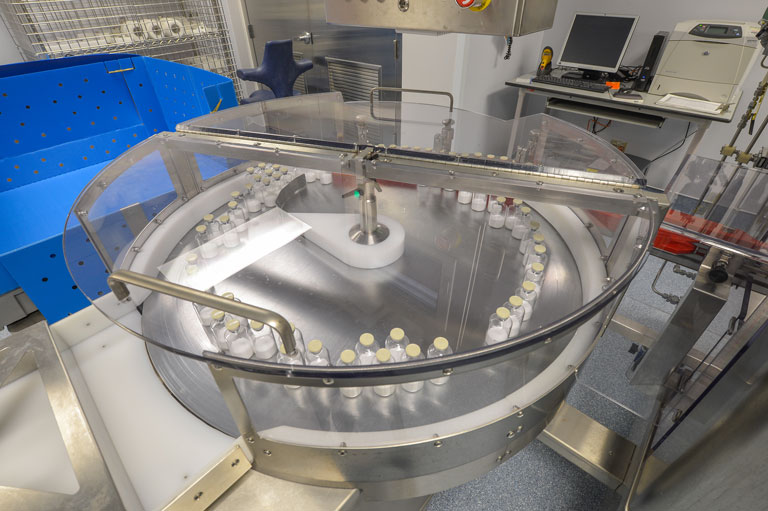By Catherine Jewell, Communications Division, WIPO
In a world with major health challenges, debates about access to medicine are understandably emotionally charged. While intellectual property (IP) is sometimes perceived as a barrier to access, the reality is more complex. A case in point is the experience of Eli Lilly in transferring its technology to produce two second-line therapies to treat multidrug-resistant tuberculosis (MDR-TB). Under the Lilly MDR-TB Partnership, the pharmaceuticals giant was able to take IP rights and pricing out of the access equation. But it still took 12 years to ensure a sustainable local supply of their drugs.

Iain Richardson, Senior Director of Global Diabetes Manufacturing at Eli Lilly and Company, was responsible for steering its largest ever philanthropic undertaking to a successful conclusion. He discusses some of the key lessons learned in transferring pharmaceutical technology to middle and low income countries.
How did the Lilly MDR-TB Partnership come about?
In the mid-1990s, Lilly’s production of cycloserine and capreomycin – antibiotics against TB – was small and sporadic and about to be phased out. But a study undertaken in 1996 by the non-profit organization Partners in Health (PIH) demonstrated that multidrug-resistant TB could be successfully treated in a resource-poor setting using these drugs as part of a cocktail of drugs. PIH’s study achieved unprecedented cure rates of over 80 percent.
These findings, coupled with evidence of alarmingly high prevalence of MDR-TB, sparked a major public health debate, and fuelled interest in cycloserine and capreomycin. But with an estimated 450,000 new cases of MDR-TB per year, Eli Lilly did not have the capacity to produce the volumes required, nor could effective generic versions of these drugs be sourced anywhere else.
The company, concerned about this looming health crisis, hit on the idea of building capacity closer to patients. If we could find partners in the four hardest-hit countries - China, India, South Africa and Russia, which account for 60 percent of MDR-TB cases worldwide - we could increase global capacity, lower manufacturing costs and provide better access to locally produced medicines. With this in mind, in 2003 the Lilly MDR-TB Partnership was launched.
What was your strategy?
We knew that the process of transferring our technology was going to take time because of the complex processes involved in making cycloserine (fermentation) and capreomycin (lypholization or freeze-drying). Each requires sophisticated equipment, specialist knowledge and adherence to good manufacturing practices. As a first step, we ramped up our internal capacity to help meet immediate needs and made the drugs available at heavily discounted prices. In a health crisis, when rapid access to treatment is a priority, a short-term solution can bridge the time it takes for the relevant technology to be transferred and for partners to become operational. That is what we sought to do.
How do you justify this approach?
Our objectives were purely philanthropic. Initially we committed USD70 million, largely to cover the discounted pricing. Twelve years later we are working with multiple stakeholders in a number of programs to improve access to quality-assured MDR-TB drugs. To date we have committed USD170 million in cash, medicines and support to our partners’ programs and to the companies making these drugs. We even extended no-strings capital investment grants to them to reduce their capital expenditure and help relieve pressure on drug pricing. We are also training healthcare professionals and working to improve public awareness about MDR-TB and treatment access.

Was it difficult to find suitable partners?
It was tough, but we knew there were capable and committed partners in the four target countries. We understood the crucial importance of developing a solid relationship with committed partners. We had to get a sense that they had what it takes to make it through WHO pre-qualification (a WHO service that ensures medicines supplied by international procurement agencies to resource-limited countries meet acceptable standards of quality, safety and efficacy). We gave them whatever they needed to be able to produce these drugs, and they didn’t disappoint. For example, thanks to our efforts and the commitment of our Russian partner, JSC BIOCOM, the company is the first and only Russian facility to have received WHO pre-qualification for any drug.
What were the key lessons learned from the technology transfer process?
In 2003 we were blazing a new trail. We soon discovered that the process of transferring technology of internationally quality-assured drugs is complex, resource-intensive and time-consuming. Medicines are unique because they must be produced according to stringent manufacturing standards to ensure safety and efficacy. Many low and middle-income countries operate standards of international quality assurance. Upgrading their operations to meet these standards is of overriding importance but takes significant effort, involves on-site training and is an expensive and lengthy process.
The technology transfer process also threw up a number of technical challenges. No two pharmaceutical facilities are identical and subtle differences, for example in the configuration of piping or the way valves open and close, can make a huge difference to a drug’s consistency and quality. On top of this, the chemistry of cycloserine (patented in 1956) and capreomycin (patented in 1962) was rather old, as were our production processes. This meant we needed to do more work on them to overcome some of the difficulties we encountered.
Is local production always the right way to go?
No one size fits all. Not all countries have the necessary technical or operating capacity or a sufficiently large market to be able to achieve the economies of scale needed to lower prices. Many factors come into play, but in our case it made sense to have local champions in markets with the highest MDR-TB prevalence. For example, in China, a country with a huge market, our partner, Zhejiang Hisun Pharmaceutical Company Limited, has succeeded in registering and producing these drugs and at lower prices than in the past. This is a major breakthrough for MDR-TB patients in that country.
What IP challenges did you face?
IP rights as such were not an issue because both cycloserine and capreomycin were off-patent. But IP in the broader sense of expertise and know-how played a critical role. We took our scientists, engineers and operations people to our partners’ plants and we also brought them to our facilities so they could observe the manufacturing process directly. We also offered training in good manufacturing practices and environmental health and safety. We gave our partners whatever they needed. In this respect IP was significant because they each had unique challenges that we needed to help them overcome. This type of IP can be more valuable than patent documents. All the same, ramping up access was a slow process, but it has led to a much broader program of access today which we are committed to further improving.
What were the main business challenges?
When Lilly undertook the technology transfer, a central aim was to help ensure a global supply of quality-assured MDR-TB medicines. But, notwithstanding a huge medical need, there was simply no market for these drugs. Despite its potential to build local, self-sustaining infrastructure, lower costs and ensure a ready supply of medicines, local production can be held back by a variety of supply-chain issues. For example, the MDR-TB drug market is highly fragmented with multiple small-scale buyers. The Global Drug Facility is the most prominent purchaser, but represents a relatively small market compared to that for other medicines. This means it is difficult for manufacturers to scale-up production in a way that would enable them to reduce prices. There are also a number of treatment regimens for MDR-TB, which effectively shrinks the market for any one treatment element. Other factors also make it difficult for manufacturers to predict demand including incomplete MDR-TB data as well as gaps in funding (up to USD3 billion per year according to WHO) and complex and often rigid funding arrangements. Such uncertainties can deter manufacturers from entering the market or from participating in technology transfer projects.
Against this backdrop, to bring our business partners on board, we had to be sure that they understood the market value of the drugs they would be producing and were assured of a return on their investment. While our motives were philanthropic, for our partners, it was business. They had to make money out of the partnership.
Is technology transfer the key to treatment access?
Our experience shows that that technology transfer is no panacea for access to treatment. There are many cogs to the access wheel. Within the TB environment, the availability of medicines is important for sure, but there are so many intertwining cogs that need to be addressed simultaneously for the engine to run. Global health programs need to be firing on all cylinders. Technology transfer is hard work. It is long, it is expensive and you have to have a sustainable business model for it to succeed. But it is achievable, and more importantly is one part of a much bigger puzzle. Within the TB environment, I think the greatest challenge is investment in health systems. It is a terrible thing to find patients, diagnose them and be unable to treat them.
MDR-TB is a very difficult disease to treat. Regular TB can be cured after six months with the right treatment. But if more resistant strains develop (due to poor diagnosis, inappropriate or incomplete treatment), that is a different ball game. MDR-TB patients face a long, complex and difficult treatment regimen that is usually administered directly by a healthcare professional. Treatment takes 18 to 24 months, patients have to take multiple drug cocktails every day, and the side effects are vicious. While the diagnosis of MDR-TB is improving, huge numbers of people living with MDR-TB still go undetected. There are many factors involved in getting people access to the care they need, but a lack of investment in healthcare infrastructure, systems and personnel is a serious bottleneck that needs to be addressed if we are to make headway in tackling this pernicious disease.
What changes would you like to see in the regulatory environment?
I think there is an urgent need to simplify and streamline regulatory processes to remove existing bottlenecks across the value chain. For example, at present, in many countries pharmaceutical companies face a double regulatory burden. To be able to supply drugs through the Global Drug Facility they need to gain international quality assurance approval from a recognized stringent regulatory authority or secure WHO pre-qualification status. They also often need to register with national authorities and fulfil a variety of other requirements. Every additional regulatory or procurement-related step required to bring a drug to market adds time and cost for the manufacturer and delays access to treatment.
What message do you have for policymakers?
Too many people living with MDR-TB are not receiving the treatment they need. If MDR-TB is not treated with a full course of effective drugs, the disease will continue to spread. Without the right healthcare infrastructure to identify, diagnose and treat patients, the act of providing medicines alone risks compounding problems of drug resistance. Only by adopting systemic, multi-sector approaches that support proven, sustainable clinical and market-based approaches will we be able to stem the spread of this age-old disease. We have detailed the lessons we have learned from this experience in a white paper entitled Seeking Solutions to a Global Health Crisis – will help others in shaping similar initiatives in the future. We hope that others will benefit from these insights when shaping similar future initiatives.


